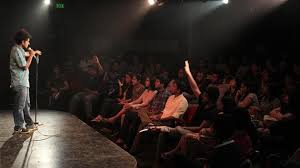Introduction: The Journey of Stand-Up Comedy
Stand-up comedy, as we know it today, has undergone remarkable changes over the years. Emerging as a raw form of entertainment, it grew through vaudeville, thrived in comedy clubs, and today enjoys global popularity thanks to streaming platforms. This evolution mirrors cultural shifts, demonstrating how humor adapts to social dynamics. Read more to explore the journey of stand-up comedy across decades and its impact on audiences worldwide
Origins: Vaudeville and Early Influences
Stand-up comedy traces its roots to the vaudeville era of the late 19th and early 20th centuries. Vaudeville shows featured various short acts, including comedians who had to engage audiences quickly between performances like music or dance. These early routines laid the groundwork for stand-up’s structure, emphasizing concise setups and punchlines.
Minstrel shows, though problematic due to their use of racial stereotypes, also influenced the form. In these performances, humor was often delivered in quick exchanges, similar to today’s stand-up routines. The eventual shift from scripted sketches to solo acts marked the beginning of the stand-up tradition【10】【12】.
Golden Age: Comedy Clubs and Iconic Performers
The mid-20th century witnessed the rise of comedy clubs, creating a dedicated space for stand-up performances. Clubs like The Comedy Store and The Improv became breeding grounds for new talent, giving comedians the freedom to experiment with styles and push boundaries. This era saw the emergence of groundbreaking performers such as:
- Richard Pryor: Known for autobiographical humor that tackled race and personal struggles.
- George Carlin: Master of political satire, famous for his controversial “Seven Words” routine.
- Joan Rivers: A trailblazer for female comedians, addressing taboo topics with sharp wit【9】【11】.
During this period, television also amplified comedians’ influence, with late-night shows offering a national platform. A successful appearance on shows like The Tonight Show could launch a comedian’s career almost overnight【9】.
Read more about : https://devtuc.com/
Modern Stand-Up: Netflix, Streaming, and the Digital Era
The digital age has revolutionized stand-up comedy, providing new ways for comedians to reach audiences. With platforms like Netflix, Hulu, and Amazon Prime, comedy specials now enjoy global accessibility. Streaming has democratized comedy, allowing comedians from diverse backgrounds to gain visibility. Online platforms such as YouTube and social media further broaden the audience base, enabling comics to share material in innovative ways【11】【13】.
Additionally, the modern landscape of stand-up reflects societal trends. Political satire, observational humor, and alternative comedy have gained popularity. Performers such as John Mulaney, Ali Wong, and Bo Burnham illustrate how comedy adapts to contemporary themes while experimenting with format and delivery【10】.
Cultural Impact: Global Reach and Diversity
Today, stand-up comedy is a worldwide phenomenon, embraced in countries beyond the U.S. and U.K. Regions such as India, Africa, and Latin America have developed their own stand-up scenes, often blending humor with local social issues. This diversification has enriched the genre, fostering a global community of comedians with unique perspectives【13】.
The rise of virtual performances during the COVID-19 pandemic also demonstrated the adaptability of stand-up. Comedians experimented with online shows, keeping the art alive in uncertain times. Today, both live performances and digital formats coexist, offering audiences more ways to enjoy comedy【12】.
Conclusion: Stand-Up Comedy’s Ever-Evolving Nature
The evolution of stand-up comedy—from its roots in vaudeville theaters to Netflix specials—highlights the genre’s ability to adapt and thrive in changing times. Each era has introduced new styles, breaking conventions and addressing societal issues with humor. As technology continues to evolve, so will the ways comedians connect with audiences, ensuring stand-up comedy remains a vital part of entertainment. Just as cultural trends like The Rise of Gender-Neutral Fashion influence mainstream conversations, comedy also reflects shifts in societal norms, keeping it relevant and engaging for modern audiences.
